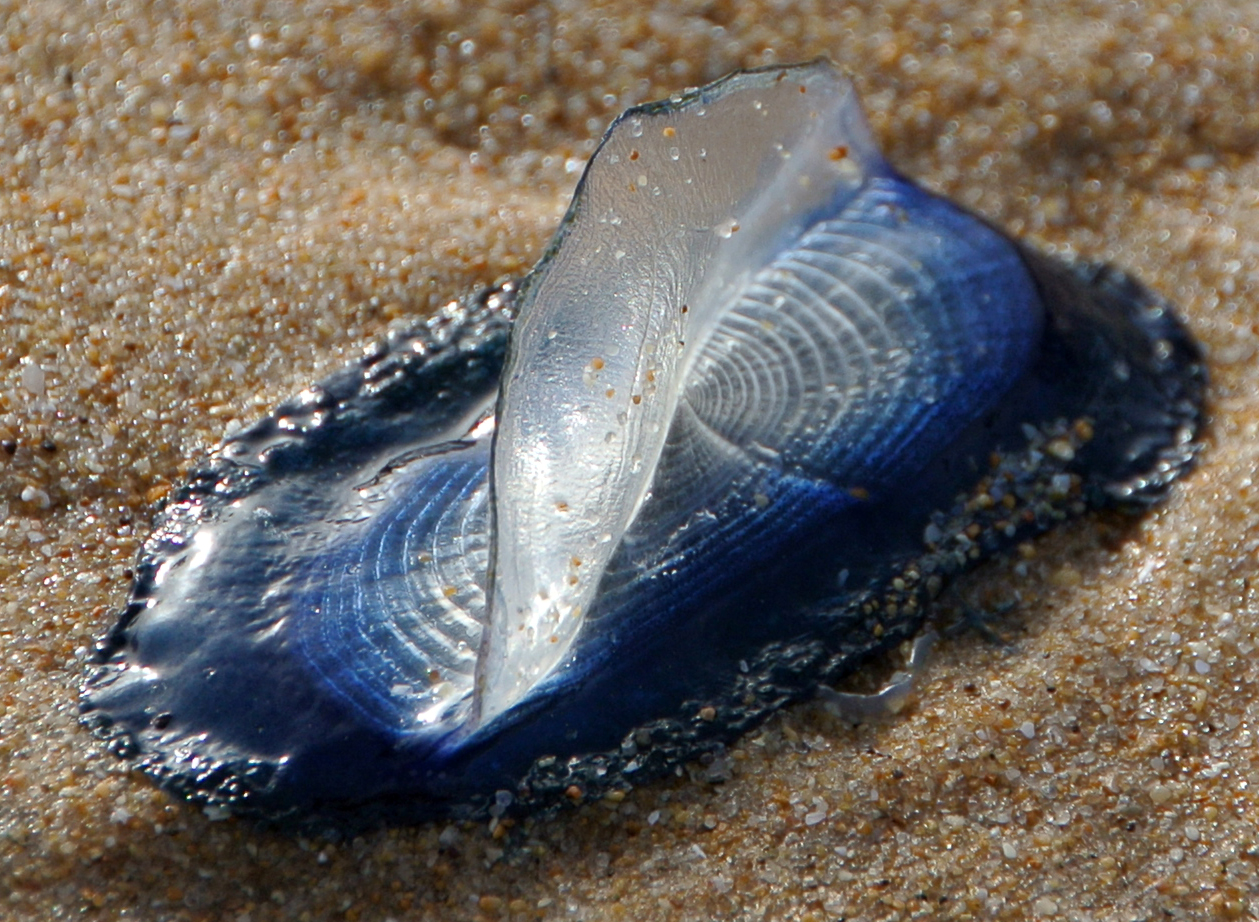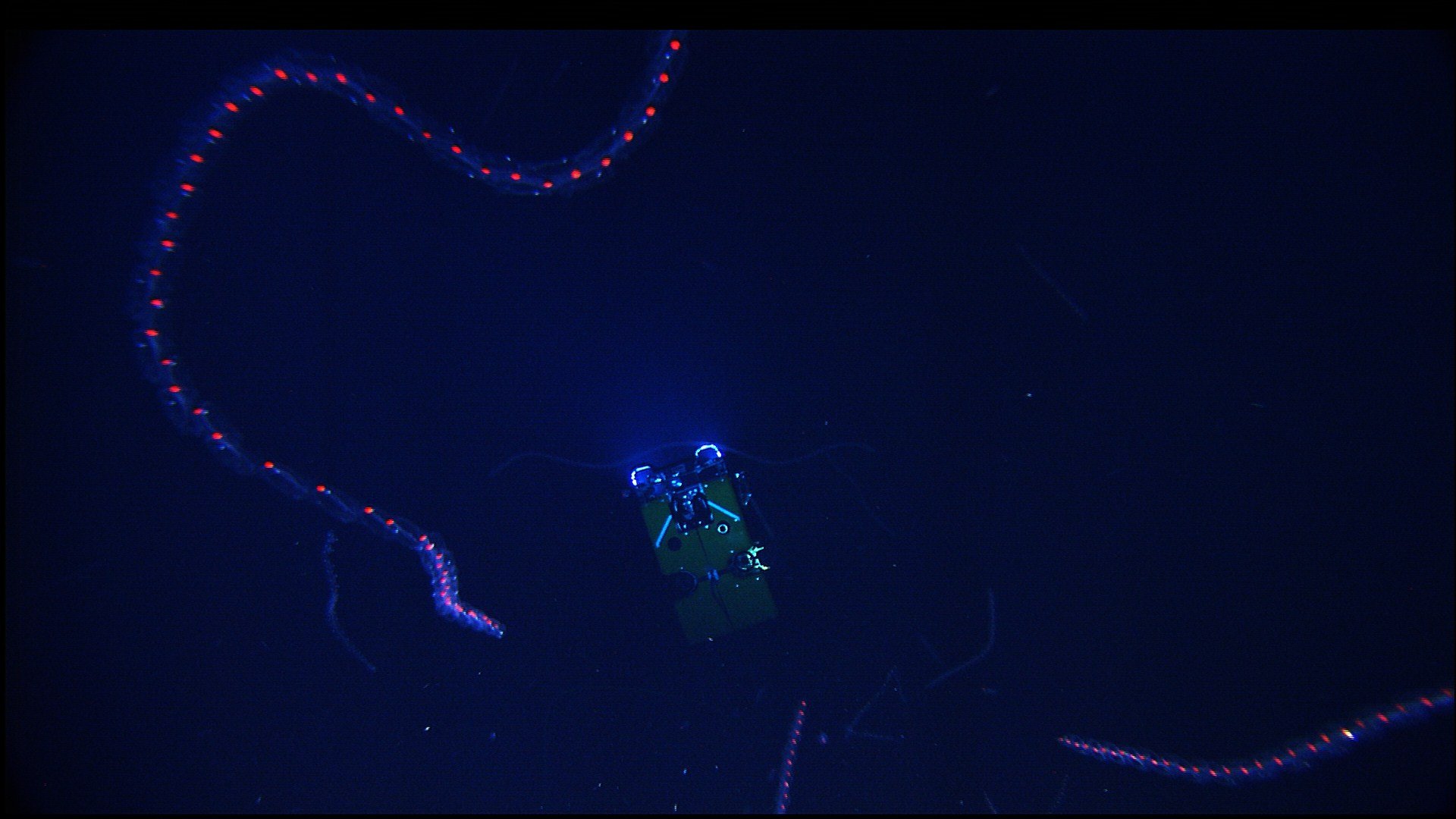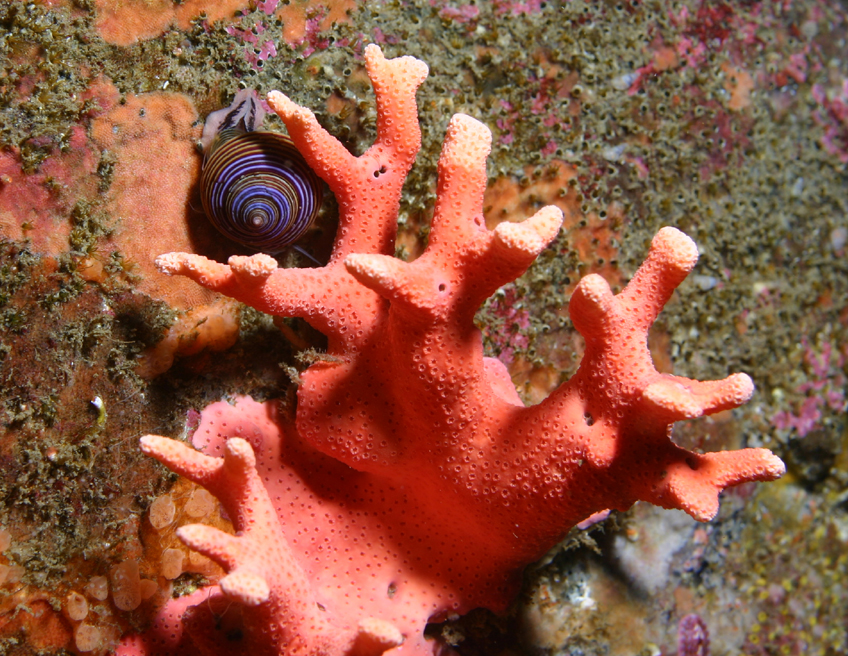|
Chondrophore
The chondrophores or porpitids are a small group of hydrozoans in the family Porpitidae. Though it derives from an outdated name for this lineage (see below), some still find the term "chondrophore" useful as a synonym to "porpitid" in discussions of the two genera contained therein. They all live at the surface of the open ocean, and are colonies of carnivorous, free-floating hydroids whose role in the plankton community is similar to that of pelagic jellyfish. The chondrophores look like a single organism but are actually colonial animals, made up of orderly cooperatives of polyps living under specialized sail-structures. The most familiar members of the family Porpitidae are the blue button (''Porpita porpita'') and the by-the-wind sailor (''Velella velella''). Description The tiny individual animals are specialized to perform specific tasks; some form the central gas-filled disc (which is a golden brown colour and hardened by chitinous material) essential to keeping the ... [...More Info...] [...Related Items...] OR: [Wikipedia] [Google] [Baidu] |
Porpita Porpita
''Porpita porpita'', or blue button, is a marine organism consisting of a colony of hydroids found in the warmer, tropical and sub-tropical waters of the Pacific, Atlantic, and Indian oceans, as well as the Mediterranean Sea and eastern Arabian Sea.Gul, Shahnawaz & Gravili, Cinzia. (2014). On the occurrence of Porpita porpita (Cnidaria: Hydrozoa) at Pakistan coast (North Arabian Sea). Marine Biodiversity Records. 7. 10.1017/S1755267214000189. It was first identified by Carl Linnaeus in 1758, under the basionym ''Medusa porpita''.Lillo, Antonio & Tiralongo, Francesco & Tondo, Elena. (2019). New Records of Porpita porpita (Linnaeus, 1758) (Cnidaria: Hydrozoa) in the Mediterranean Sea. Natural and Engineering Sciences. 4. 293-298. 10.28978/nesciences.646425.Calder, Dale. (2010). Some anthoathecate hydroids and limnopolyps (Cnidaria, Hydrozoa) from the Hawaiian archipelago. Zootaxa. 2590. 10.11646/zootaxa.2590.1.1. In addition, it is one of the two genera under the suborder Chondropho ... [...More Info...] [...Related Items...] OR: [Wikipedia] [Google] [Baidu] |
Plankton
Plankton are the diverse collection of organisms found in Hydrosphere, water (or atmosphere, air) that are unable to propel themselves against a Ocean current, current (or wind). The individual organisms constituting plankton are called plankters. In the ocean, they provide a crucial source of food to many small and large aquatic organisms, such as bivalves, fish and whales. Marine plankton include bacteria, archaea, algae, protozoa and drifting or floating animals that inhabit the saltwater of oceans and the brackish waters of estuaries. Freshwater plankton are similar to marine plankton, but are found in the freshwaters of lakes and rivers. Plankton are usually thought of as inhabiting water, but there are also airborne versions, the aeroplankton, that live part of their lives drifting in the atmosphere. These include plant spores, pollen and wind-scattered seeds, as well as microorganisms swept into the air from terrestrial dust storms and oceanic plankton swept into the air ... [...More Info...] [...Related Items...] OR: [Wikipedia] [Google] [Baidu] |
Proterozoic
The Proterozoic () is a geological eon spanning the time interval from 2500 to 538.8million years ago. It is the most recent part of the Precambrian "supereon". It is also the longest eon of the Earth's geologic time scale, and it is subdivided into three geologic eras (from oldest to youngest): the Paleoproterozoic, Mesoproterozoic, and Neoproterozoic. The Proterozoic covers the time from the appearance of oxygen in Earth's atmosphere to just before the proliferation of complex life (such as trilobites or corals) on the Earth. The name ''Proterozoic'' combines two forms of ultimately Greek origin: meaning 'former, earlier', and , 'of life'. The well-identified events of this eon were the transition to an oxygenated atmosphere during the Paleoproterozoic; the evolution of eukaryotes; several glaciations, which produced the hypothesized Snowball Earth during the Cryogenian Period in the late Neoproterozoic Era; and the Ediacaran Period (635 to 538.8 Ma) which is characterize ... [...More Info...] [...Related Items...] OR: [Wikipedia] [Google] [Baidu] |
Capitata
Capitata is a suborder of Hydrozoa, a class of marine invertebrates belonging to the phylum Cnidaria. Characteristics Members of this suborder are characterised by the tentacles of the polyps terminating in knobs. In some species these are only present in juvenile forms being replaced in adults by more threadlike tentacles. A high nematocyst concentration is present in the knobs. A few species in this group are better known as their solitary medusa form than as their polyp form. These include ''Sarsia'', '' Polyorchis'' and '' Cladonema''. Families According to the World Register of Marine Species, the following families are found in this suborder : * Asyncorynidae Kramp, 1949 * Cladocorynidae Allman, 1872 * Cladonematidae Gegenbaur, 1857 * Corynidae Johnston, 1836 * Halimedusidae Arai & Brinckmann-Voss, 1980 * Hydrocorynidae Rees, 1957 *Milleporidae Fleming, 1828 * Moerisiidae Poche, 1914 * Pennariidae McCrady, 1859 *Porpitidae Goldfuss, 1818 * Pseudosolanderiidae Bouillo ... [...More Info...] [...Related Items...] OR: [Wikipedia] [Google] [Baidu] |
Suborder
Order ( la, ordo) is one of the eight major hierarchical taxonomic ranks in Linnaean taxonomy. It is classified between family and class. In biological classification, the order is a taxonomic rank used in the classification of organisms and recognized by the nomenclature codes. An immediately higher rank, superorder, is sometimes added directly above order, with suborder directly beneath order. An order can also be defined as a group of related families. What does and does not belong to each order is determined by a taxonomist, as is whether a particular order should be recognized at all. Often there is no exact agreement, with different taxonomists each taking a different position. There are no hard rules that a taxonomist needs to follow in describing or recognizing an order. Some taxa are accepted almost universally, while others are recognized only rarely. The name of an order is usually written with a capital letter. For some groups of organisms, their orders may follow ... [...More Info...] [...Related Items...] OR: [Wikipedia] [Google] [Baidu] |
Hydrozoan
Hydrozoa (hydrozoans; ) are a taxonomic class of individually very small, predatory animals, some solitary and some colonial, most of which inhabit saline water. The colonies of the colonial species can be large, and in some cases the specialized individual animals cannot survive outside the colony. A few genera within this class live in freshwater habitats. Hydrozoans are related to jellyfish and corals and belong to the phylum Cnidaria. Some examples of hydrozoans are the freshwater jelly (''Craspedacusta sowerbyi''), freshwater polyps ('' Hydra''), ''Obelia'', Portuguese man o' war (''Physalia physalis''), chondrophores (Porpitidae), "air fern" (''Sertularia argentea''), and pink-hearted hydroids (''Tubularia''). Anatomy Most hydrozoan species include both a polypoid and a medusoid stage in their lifecycles, although a number of them have only one or the other. For example, ''Hydra'' has no medusoid stage, while '' Liriope'' lacks the polypoid stage. Polyps The hydroid fo ... [...More Info...] [...Related Items...] OR: [Wikipedia] [Google] [Baidu] |
Siphonophorae
Siphonophorae (from Greek ''siphōn'' 'tube' + ''pherein'' 'to bear') is an order within Hydrozoa, which is a class of marine organisms within the phylum Cnidaria. According to the World Register of Marine Species, the order contains 175 species thus far. Although a siphonophore may appear to be an individual organism, each specimen is in fact a colonial organism composed of medusoid and polypoid zooids that are morphologically and functionally specialized. Zooids are multicellular units that develop from a single fertilized egg and combine to create functional colonies able to reproduce, digest, float, maintain body positioning, and use jet propulsion to move. Most colonies are long, thin, transparent floaters living in the pelagic zone. Like other hydrozoans, some siphonophores emit light to attract and attack prey. While many sea animals produce blue and green bioluminescence, a siphonophore in the genus ''Erenna'' was only the second life form found to produce a red li ... [...More Info...] [...Related Items...] OR: [Wikipedia] [Google] [Baidu] |
Anthomedusae
Anthoathecata, or the athecate hydroids, are an order of hydrozoans belonging to the phylum Cnidaria. A profusion of alternate scientific names exists for this long-known, heavily discussed, and spectacular group. It has also been called Gymnoblastea and (with or without an emended ending ''-ae''), Anthomedusa, Athecata, Hydromedusa, and Stylasterina. There are about 1,200 species worldwide.Schuchert, P. (2014). Anthoathecata. Accessed through: Schuchert, P. (2014) World Hydrozoa database at http://www.marinespecies.org/hydrozoa/aphia.php?p=taxdetails&id=13551 on 2014-10-31 These hydrozoans always have a polyp stage. Their hydranths grow either solitary or in colonies. There is no firm perisarc around the polyp body. The medusae, or jellyfish, are solitary animals, with tentacles arising from the bell margin, lacking statocysts but possessing radial canals. Their gonads are on the manubrium ("handle").Bouillon, J.; Gravili, C.; Pagès, F.; Gili, J.-M.; Boero, F. (2006). An intro ... [...More Info...] [...Related Items...] OR: [Wikipedia] [Google] [Baidu] |
Order (biology)
Order ( la, wikt:ordo#Latin, ordo) is one of the eight major hierarchical taxonomic ranks in Linnaean taxonomy. It is classified between Family_(biology), family and Class_(biology), class. In biological classification, the order is a taxonomic rank used in the classification of organisms and recognized by the nomenclature codes. An immediately higher rank, superorder, is sometimes added directly above order, with suborder directly beneath order. An order can also be defined as a group of related families. What does and does not belong to each order is determined by a taxonomist, as is whether a particular order should be recognized at all. Often there is no exact agreement, with different taxonomists each taking a different position. There are no hard rules that a taxonomist needs to follow in describing or recognizing an order. Some taxa are accepted almost universally, while others are recognized only rarely. The name of an order is usually written with a capital letter. Fo ... [...More Info...] [...Related Items...] OR: [Wikipedia] [Google] [Baidu] |
Mantle (biology)
A mantle is a piece of clothing, a type of cloak. Several other meanings are derived from that. Mantle may refer to: *Mantle (clothing), a cloak-like garment worn mainly by women as fashionable outerwear **Mantle (vesture), an Eastern Orthodox vesture worn by monastics and higher clergy **Mantle (royal garment), a garment worn by monarchs and princes as a symbol of authority **Mantle (heraldry), a heraldic element *Mantle (geology), a layer in the interior of a planet ** The Earth's mantle *Mantle (surname) *Mantle, a feature of bird anatomy *Mantle (climbing), the external covering of a climbing rope. *Mantle, a black and white dog coat colour, especially in Great Danes *Mantle (mollusc), a layer of tissue in molluscs which secretes the shell *Fireplace mantle or mantel, the hood over the grate of a fire *Gas mantle, a device for generating bright white light when heated by a flame *Mantle Site, Wendat (Huron) Ancestral Village, in Whitchurch-Stouffville, near Toronto *Mantle (API ... [...More Info...] [...Related Items...] OR: [Wikipedia] [Google] [Baidu] |
Turquoise (color)
Turquoise ( ) is a blue-green color, based on the mineral of the same name. The word ''turquoise'' dates to the 17th century and is derived from the French , meaning 'Turkish', because the mineral was first brought to Europe through Turkey from mines in the historical Khorasan province of Iran (Persia) and Afghanistan. The first recorded use of ''turquoise'' as a color name in English was in 1573. The X11 color named turquoise is displayed on the right. Turquoise gemstones Turquoise is an opaque, blue-to-green mineral that is a hydrous phosphate of copper and aluminium, with the chemical formula Cu Al6( P O4)4(O H)8·4 H2O. It is rare and valuable in finer grades and has been prized as a gem and ornamental stone for thousands of years owing to its unique hue. In many cultures of the Old and New Worlds, this gemstone has been esteemed for thousands of years as a holy stone, a bringer of good fortune or a talisman. The oldest evidence for this claim was found in ancien ... [...More Info...] [...Related Items...] OR: [Wikipedia] [Google] [Baidu] |
Cellophane
Cellophane is a thin, transparent sheet made of regenerated cellulose. Its low permeability to air, oils, greases, bacteria, and liquid water makes it useful for food packaging. Cellophane is highly permeable to water vapour, but may be coated with nitrocellulose lacquer to prevent this. Cellophane is also used in transparent pressure-sensitive tape, tubing and many other similar applications. Cellophane is compostable and biodegradable, and can be obtained from biomaterials. Production, however, uses carbon disulfide (CS2), which has been found to be highly toxic to workers. The lyocell process, however, can be used to produce cellulose film without involving carbon disulfide. "Cellophane" is a generic term in some countries, while in other countries it is a registered trademark. Production Cellulose from wood, cotton, hemp, or other sources is dissolved in alkali and carbon disulfide to make a solution called viscose, which is then extruded through a slit into a bath of dilu ... [...More Info...] [...Related Items...] OR: [Wikipedia] [Google] [Baidu] |







